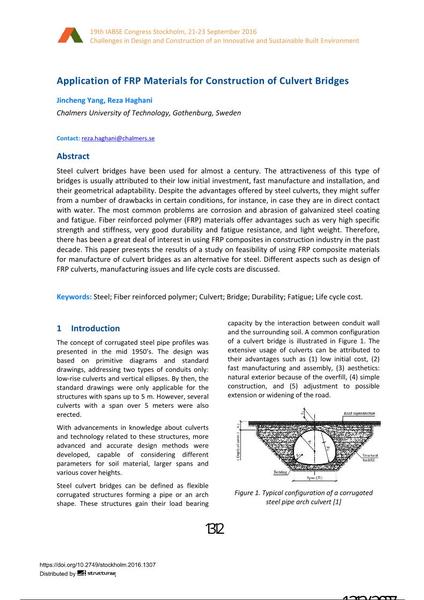Application of FRP Materials for Construction of Culvert Bridges

|
|
|||||||||||
Détails bibliographiques
| Auteur(s): |
Reza Haghani
(Chalmers University of Technology, Gothenburg, Sweden)
Jincheng Yang (Chalmers University of Technology, Gothenburg, Sweden) |
||||
|---|---|---|---|---|---|
| Médium: | papier de conférence | ||||
| Langue(s): | anglais | ||||
| Conférence: | IABSE Congress: Challenges in Design and Construction of an Innovative and Sustainable Built Environment, Stockholm, Sweden, 21-23 September 2016 | ||||
| Publié dans: | IABSE Congress Stockholm, 2016 | ||||
|
|||||
| Page(s): | 1312-1319 | ||||
| Nombre total de pages (du PDF): | 8 | ||||
| Année: | 2016 | ||||
| DOI: | 10.2749/stockholm.2016.1307 | ||||
| Abstrait: |
Steel culvert bridges have been used for almost a century. The attractiveness of this type of bridges is usually attributed to their low initial investment, fast manufacture and installation, and their geometrical adaptability. Despite the advantages offered by steel culverts, they might suffer from a number of drawbacks in certain conditions, for instance, in case they are in direct contact with water. The most common problems are corrosion and abrasion of galvanized steel coating and fatigue. Fiber reinforced polymer (FRP) materials offer advantages such as very high specific strength and stiffness, very good durability and fatigue resistance, and light weight. Therefore, there has been a great deal of interest in using FRP composites in construction industry in the past decade. This paper presents the results of a study on feasibility of using FRP composite materials for manufacture of culvert bridges as an alternative for steel. Different aspects such as design of FRP culverts, manufacturing issues and life cycle costs are discussed. |
||||
| Mots-clé: |
acier pont
|
||||
